Hiring has developed, and traditional methods like job boards and cold outreach are becoming less effective. A recent report analyzed data from over 2 million job candidates and found that referred candidates were over 4.5 times as likely to get hired compared to those without referrals.
That’s where AI recruiting tools come in. They promise faster sourcing, smarter screening, and fewer missed connections, but which ones actually deliver?
This guide explores ten of the best AI recruiting tools in 2025, highlighting their features, pricing, and how they can transform your hiring strategy.
What Is an AI Recruiting Tool?
AI recruiting tools help you hire faster by removing repetitive tasks from your workflow. Instead of manually scanning resumes or sending cold emails, these platforms use algorithms to surface qualified candidates and handle early-stage steps for you.
You’ll find AI embedded into many parts of the recruiting process, but not every tool does the same thing. Some focus on sourcing. Others help with screening, interviews, or candidate communication.
If you want to reduce manual work, improve candidate matches, or stop missing great hires because of slow outreach, AI recruiting software can help.
How Does AI Make the Recruitment Process Easier?
Here are a few ways AI makes hiring easier:
- Ranks candidates based on job fit and past experience
- Gathers data from LinkedIn, GitHub, job boards, and more
- Sends personalized follow-up messages at the right time
- Books interviews based on availability
- Flags bias and surfaces candidates you might otherwise overlook
Many of these tools also learn from your past decisions. Over time, they get smarter and more relevant to your team’s goals.
Who Should Use AI Recruiting Tools?
AI recruiting tools are built for speed and scale. If your team is juggling too many roles, dealing with a shallow pipeline, or spending hours on manual outreach, it's time to consider them.
These platforms work especially well for:
- HR teams looking to automate resume screening and early communication
- Recruiting teams managing a large volume of job candidates across departments
- Talent acquisition teams responsible for improving efficiency and reducing time to hire
- Startups and staffing firms that need to move fast without compromising on quality
- Enterprise companies navigating complex, multi-step recruitment processes
Even if you’re only hiring a few roles, these platforms help you find suitable candidates faster. You can spend more time interviewing and less time chasing people who aren’t a fit.
And if your goal is to build a stronger talent pool over time, AI helps you source, track, and re-engage the right people before your competitors do.
10 AI Recruiting Tools to Consider in 2025
If you are looking for tools that save time, reduce friction, and improve results, you are in the right place. These platforms bring real structure and speed to your recruiting efforts.
Some focus on sourcing, others on automation or engagement, but each one solves a different part of the hiring process.
Below are the top 10 AI recruiting tools to make your recruiting process easier:
1. Village — Best for Turning Networks Into Hires
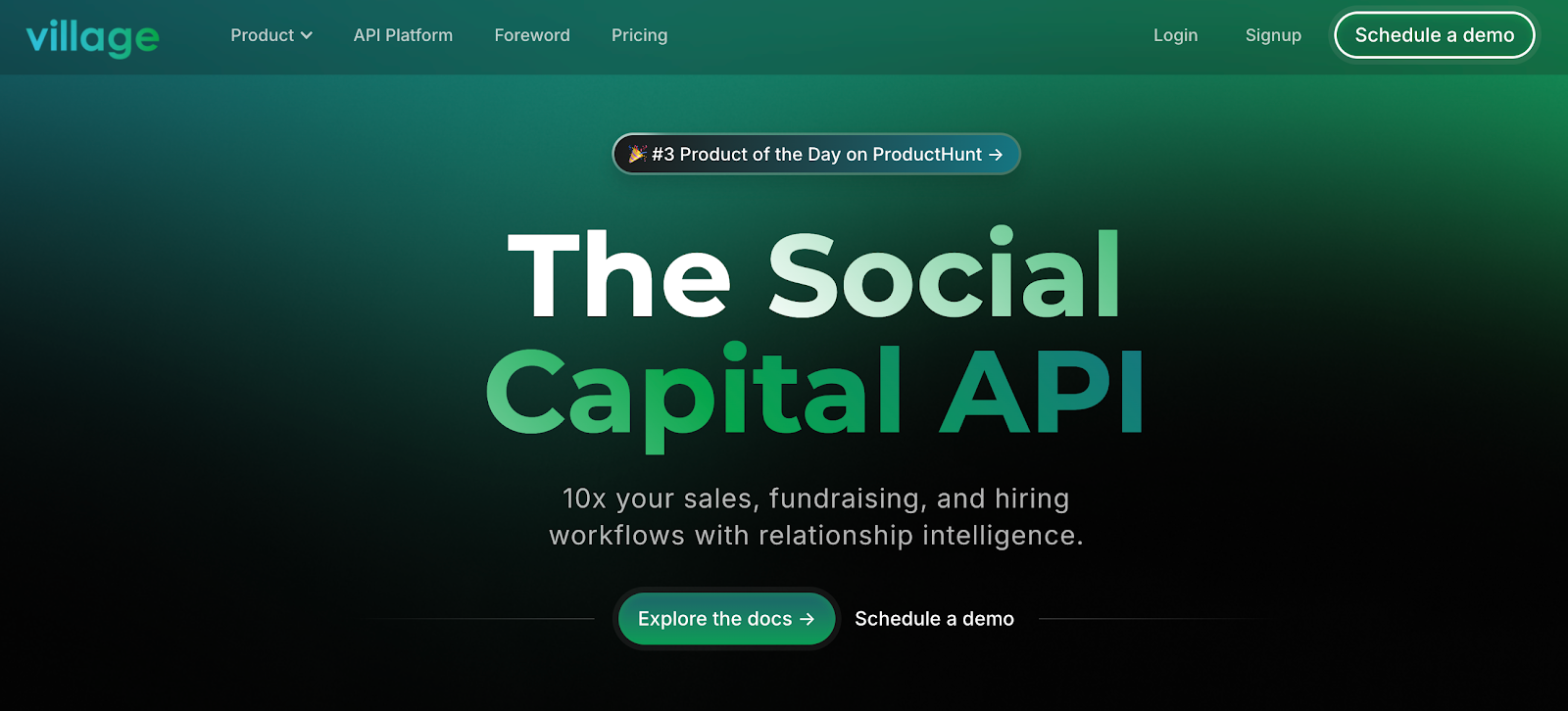
Village is not a recruiting tool in the traditional sense. It’s a relationship intelligence platform powered by AI, built to help people reach the right hiring contacts through trusted introductions.
Instead of scanning resumes or sending cold emails, Village finds intro paths based on shared connections, past interactions, and actual network strength. If you want to help candidates or platforms unlock real opportunities through relationships, this is the tool to start with.
Key Features
- Maps warm intros from synced email, calendar, and LinkedIn data
- Built-in AI tools to manage intro requests, boards, and messaging
- Paths Explorer widget or API integrates into job boards and customer relationship management systems (CRMs)
- Scores relationships based on strength and shared history
Village is best suited for talent platforms that want to offer high-conversion referral paths instead of relying on job listings. It also works well for hiring teams looking to connect with referred candidates instead of filtering through cold applicants.
Career communities, advisors, and platforms that help users grow their careers can use Village to open doors that job boards cannot.
Pros
Village helps you identify and act on high-quality relationships instead of wasting time on cold leads. It's flexible, embeddable, and works with your existing workflows. The AI gives you not just the contact but the context, too.
Pricing
- Free trial
- Essentials: $19 per month
- Pro: $39 per month
- Premium: $119 per month
If your goal is to connect the right people, Village is the most strategic way to turn networks into hires.
Schedule a demo and see how warm intros change the way you recruit!
2. Workable — Best for All-in-One Recruiting Workflows
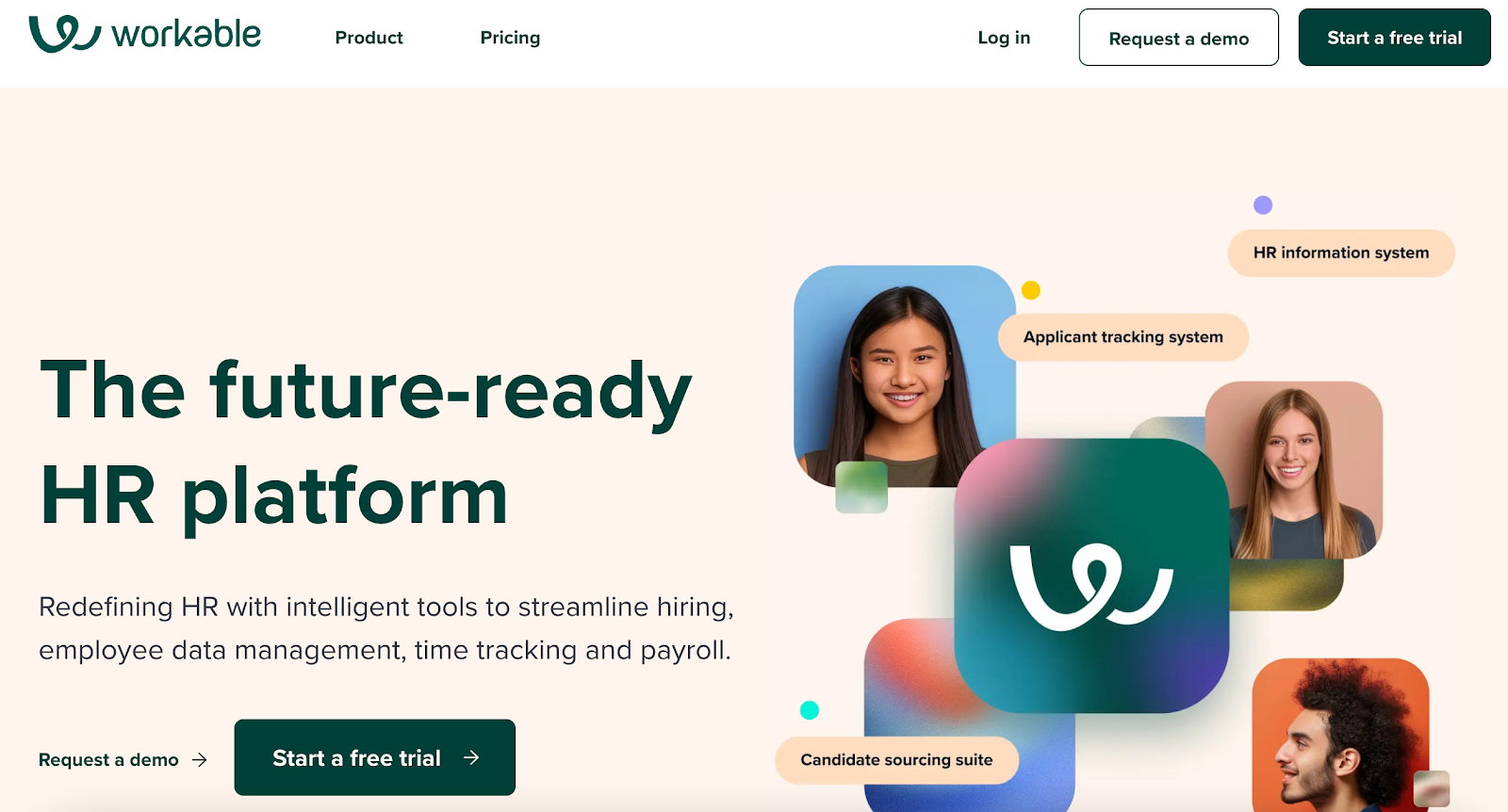
If you want a platform that handles job posting, candidate tracking, and offer management in one place, Workable is a solid choice. It’s built for in-house teams that need structure without a steep learning curve.
Workable supports the full recruitment process from end to end. You can create job descriptions, publish listings to over 200 boards, screen candidates with AI, and move them through customizable hiring stages.
Key Features
- One-click distribution to 200-plus job postings
- AI-assisted screening and candidate scoring
- Self-scheduling for interviews
- Custom scorecards, templates, and offer letters
- Mobile access and strong analytics dashboard
Workable is suitable for small to mid-sized companies that hire regularly and want one system to manage everything. It’s also helpful for internal recruiting teams that don’t have the time or budget to juggle multiple tools.
Pros
It’s easy to get started, and the interface is clean and intuitive. You can automate a lot of the admin work and keep everything, from resumes to notes to interview stages, in one place.
Cons
Mobile access is limited. If you do most of your work on the go, you may run into performance issues. It’s also not built for large enterprise teams with complex internal approvals.
Pricing
- Starter: From $169 per month
- Standard: From $360 per month (pricing varies by team size)
3. Eightfold — Best for Enterprise-Scale Talent Intelligence
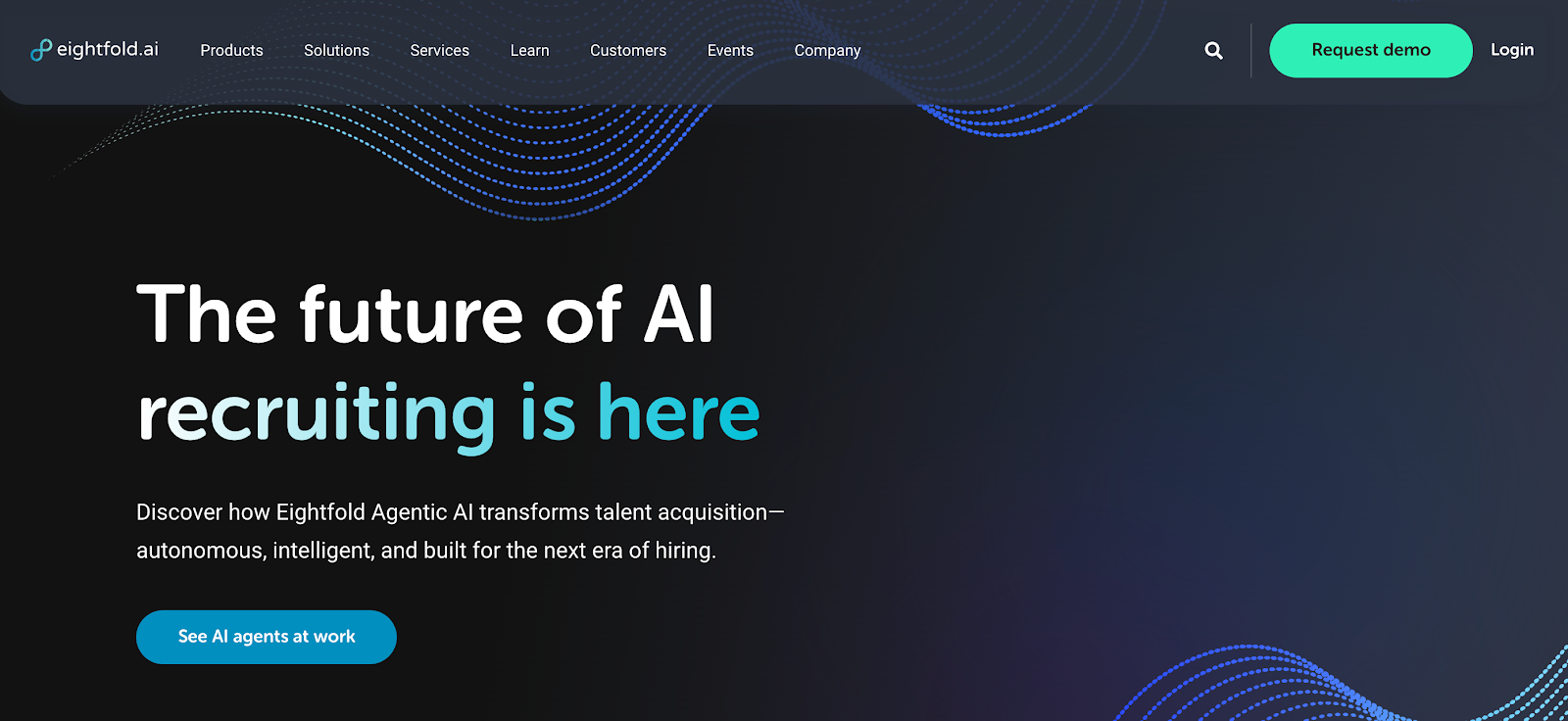
If you’re hiring at scale or managing thousands of employee records, Eightfold brings serious power to the table. This is not a tool for early-stage teams. It’s built for large organizations that need deep AI capabilities across the entire talent acquisition lifecycle.
Eightfold uses artificial intelligence to help companies recruit, retain, and grow their workforce. It goes beyond sourcing and offers insights into internal mobility, diversity hiring, and succession planning.
Key Features
- AI-based talent matching across internal and external candidates
- Diversity hiring tools built into the core system
- Career pathing, retention insights, and upskilling recommendations
- Chrome extension for sourcing
- Enterprise-grade security and data compliance
Eightfold is suitable for global companies with thousands of employees and a mature talent acquisition process. If you need one system to manage new hires, internal promotions, and future leadership planning, it delivers.
Pros
It handles scale well and offers powerful automation for matching, ranking, and redistributing talent. It also supports strategic initiatives like reducing attrition and planning for long-term growth.
Cons
The interface is not as intuitive as it should be. Reporting can feel overwhelming, especially if you're used to simpler recruitment tools. It also takes time to configure and fully integrate.
Pricing
Eightfold's pricing is not available to the public.
4. Manatal — Best for Customizable Pipelines
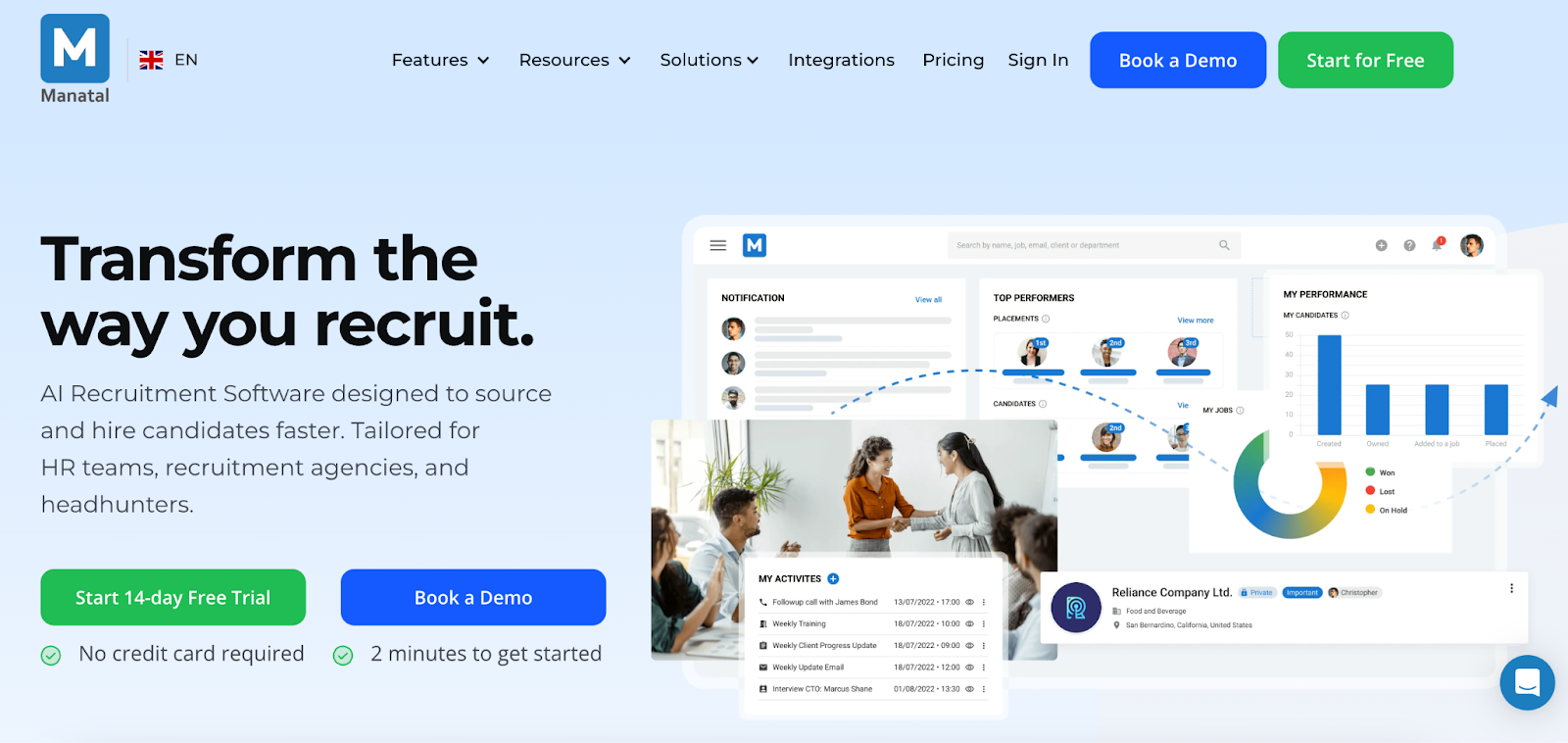
Manatal gives you a flexible, drag-and-drop system to organize your entire recruiting process. It’s ideal if you want structure without losing control over how you move candidates through your funnel.
You can create custom pipelines, manage job ads, and enrich candidate profiles with data pulled from social media. It also includes a built-in CRM for managing client and candidate communication.
Key Features
- Drag-and-drop pipeline builder
- Candidate enrichment with LinkedIn and resume data
- Career page builder and branding tools
- Built-in CRM and ATS
- Visual reports for hiring metrics
Manatal works well for smaller teams, staffing agencies, and companies that want to customize their workflows. If you need flexibility without sacrificing core ATS features, it’s a strong option.
Pros
It’s quick to set up and doesn’t require training to use. The pipeline view is clean, and the reports give you a helpful snapshot of performance across roles.
Cons
Archived candidates don’t always show up in search, which can create extra work. The Chrome extension also tends to lag during sourcing candidate sessions.
Pricing
- Professional: $19 per user per month
- Enterprise: $39 per user per month
- Enterprise plus: $59 per user per month
5. hireEZ — Best for Outbound Sourcing and Contact Data
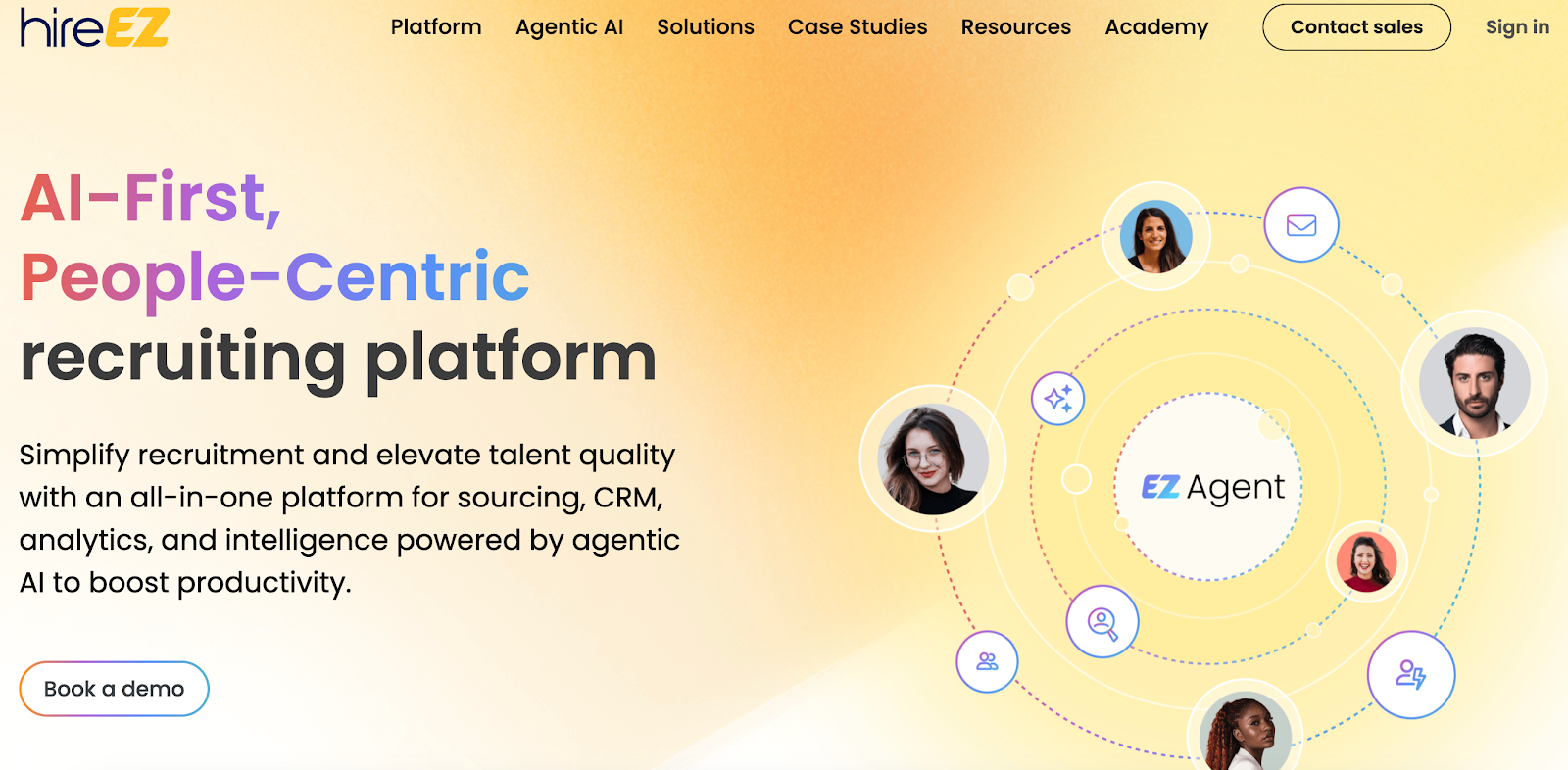
hireEZ focuses on outbound recruiting. If you’re actively hunting for passive candidates and need accurate contact info fast, this tool gives you a strong edge.
It pulls from over 700 million profiles across platforms like LinkedIn, GitHub, and portfolios. You can filter by skills, experience, and engagement history, then use built-in tools to reach out directly.
Key Features
- AI-powered search across 45-plus platforms
- Contact enrichment with emails and phone numbers
- CRM for managing outreach and follow-up
- Chrome extension for on-the-fly sourcing
- Team collaboration and talent pipeline tracking
hireEZ is helpful for recruiters and sourcers who spend most of their time finding and reaching out to candidates. It’s especially useful for agency teams or companies hiring for technical roles.
Pros
You get access to contact info up front, which speeds up outreach. It also helps you prioritize the most qualified candidates and follow up with them at the right time.
Cons
The free version limits how many contacts you can access. In rare cases, the system may mismatch candidate data or show outdated profiles.
Pricing
hireEZ doesn't list their pricing options publicly.
6. TurboHire — Best for Automating the Full Hiring Journey
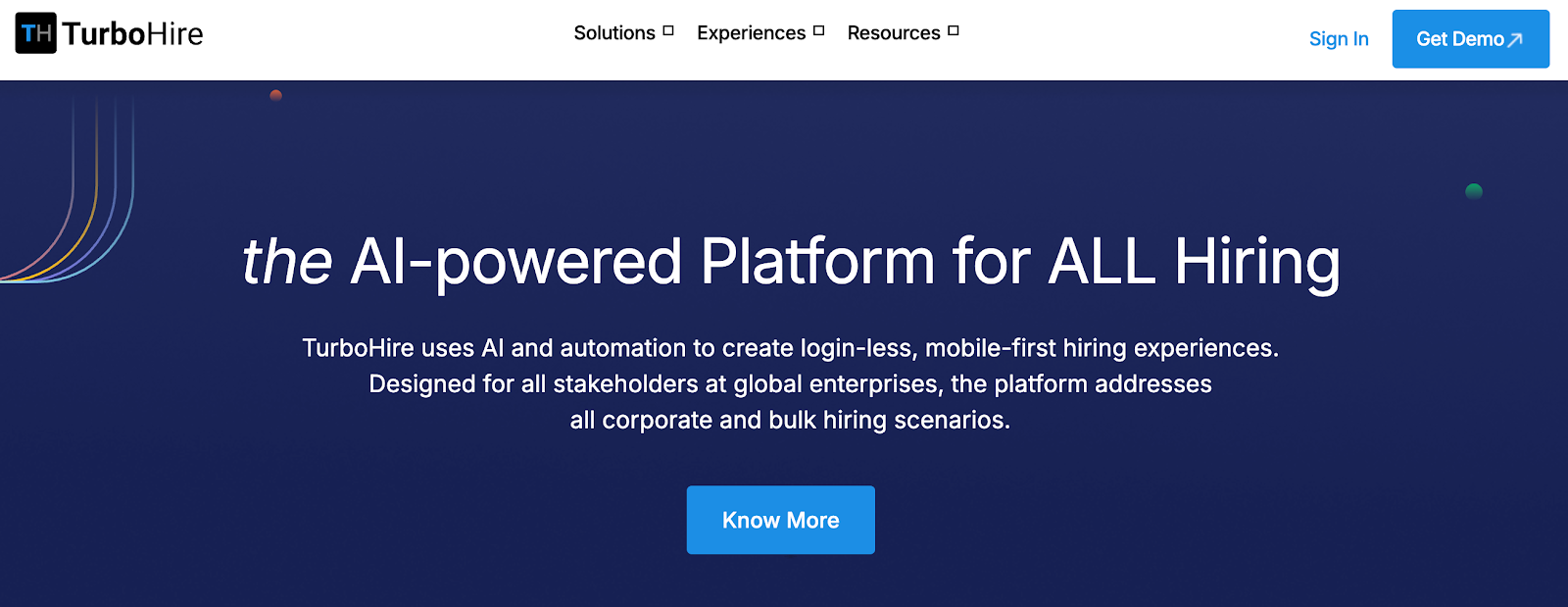
TurboHire is built for automation across every stage of the hiring process. From screening to onboarding, it helps you reduce manual work and move faster without losing visibility.
The platform combines AI with structured workflows so you can rank candidates, run one-way interviews, and generate offers without jumping between tools.
Key Features
- AI-based candidate ranking by skills and experience
- Built-in chatbot and video interview options
- Offer letter generation and onboarding tools
- Login-free experience for candidates and interviewers
- Visual dashboards for pipeline tracking
TurboHire is suitable for mid-sized companies and high-growth teams that want automation across sourcing, screening, and final selection. It’s also helpful if your recruiting tools need to support multiple internal stakeholders without creating extra steps.
Pros
The platform saves time by automating tasks like resume review and follow-ups. Its thumbs-up and down features help you evaluate candidates quickly during the early stages.
Cons
There’s no way to leave personal notes about candidates once outreach begins, which can make handoffs harder. The reporting features also fall short for teams needing high-level insights.
Pricing
TurboHire doesn't disclose its pricing to the public.
7. Recruit CRM — Best for Global Recruiting Agencies
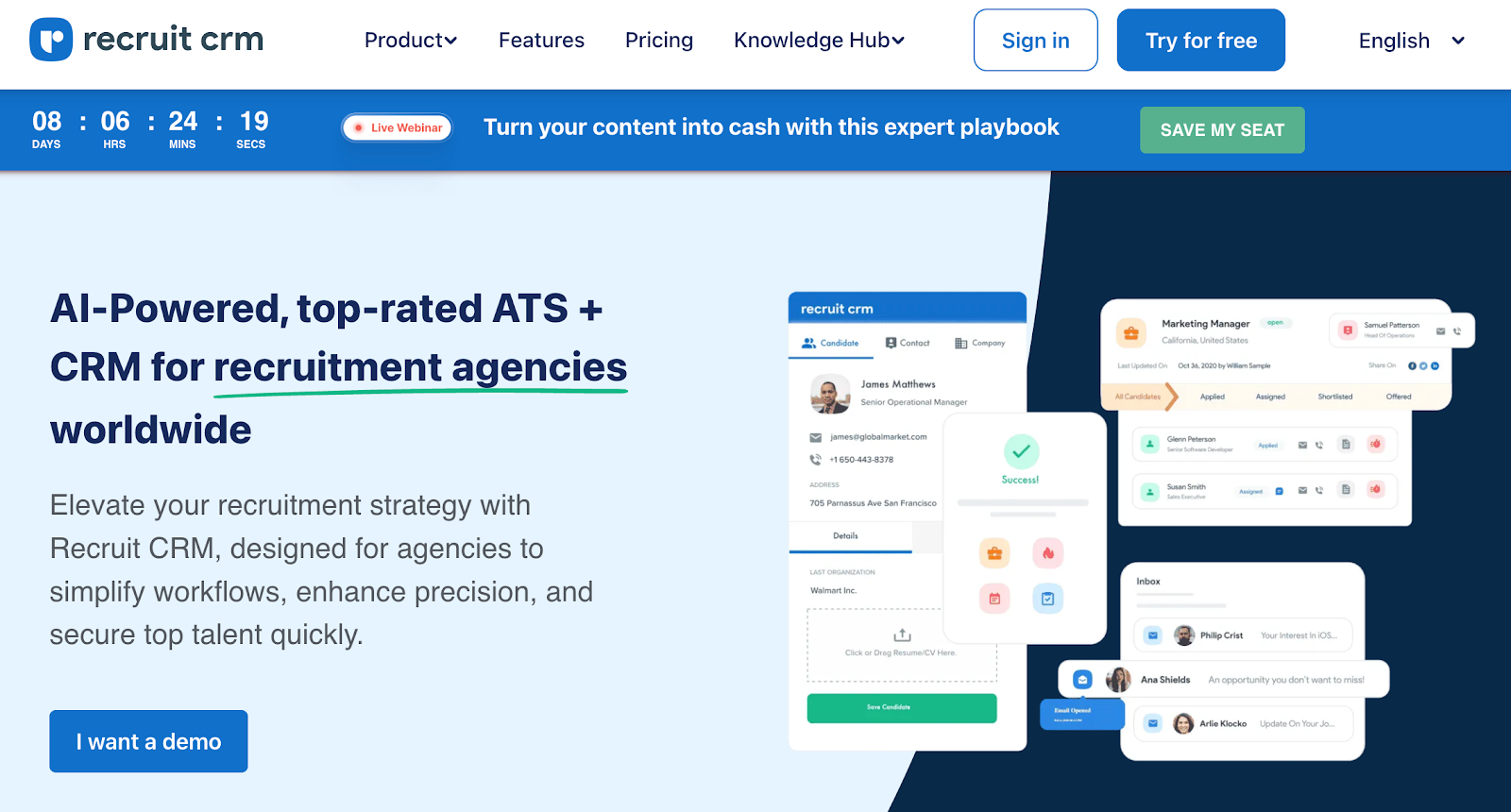
Recruit CRM combines an applicant tracking system with a full-featured CRM, making it a decent fit for agencies that manage multiple clients and roles at once. It’s designed to help you organize outreach, track submissions, and keep your recruiting team on the same page.
You can source candidates from LinkedIn and Gmail using their Chrome extension, then manage follow-ups, emails, and job progress all in one place.
Key Features
- Built-in ATS with drag-and-drop pipeline
- CRM to manage clients, candidates, and deals
- Chrome extension for easy candidate sourcing
- Reporting tools for tracking placements and performance
Recruit CRM is for agencies that need to manage roles, track conversations, and maintain visibility across teams. It’s also a good fit for smaller firms that want a more integrated recruiting software experience without custom development.
Pros
The interface is simple, and customer support is responsive. It makes it easy to manage both candidate and client communication from one place.
Cons
Some basic features, like spell check in email campaigns, are missing. It also lacks native integrations with certain third-party tools unless you use a paid connector.
Pricing
- Pro: $50 per user per month
- Business: $75 per user per month
- Enterprise: $79 per user per month
8. Phenom — Best for Enhancing the Candidate Experience
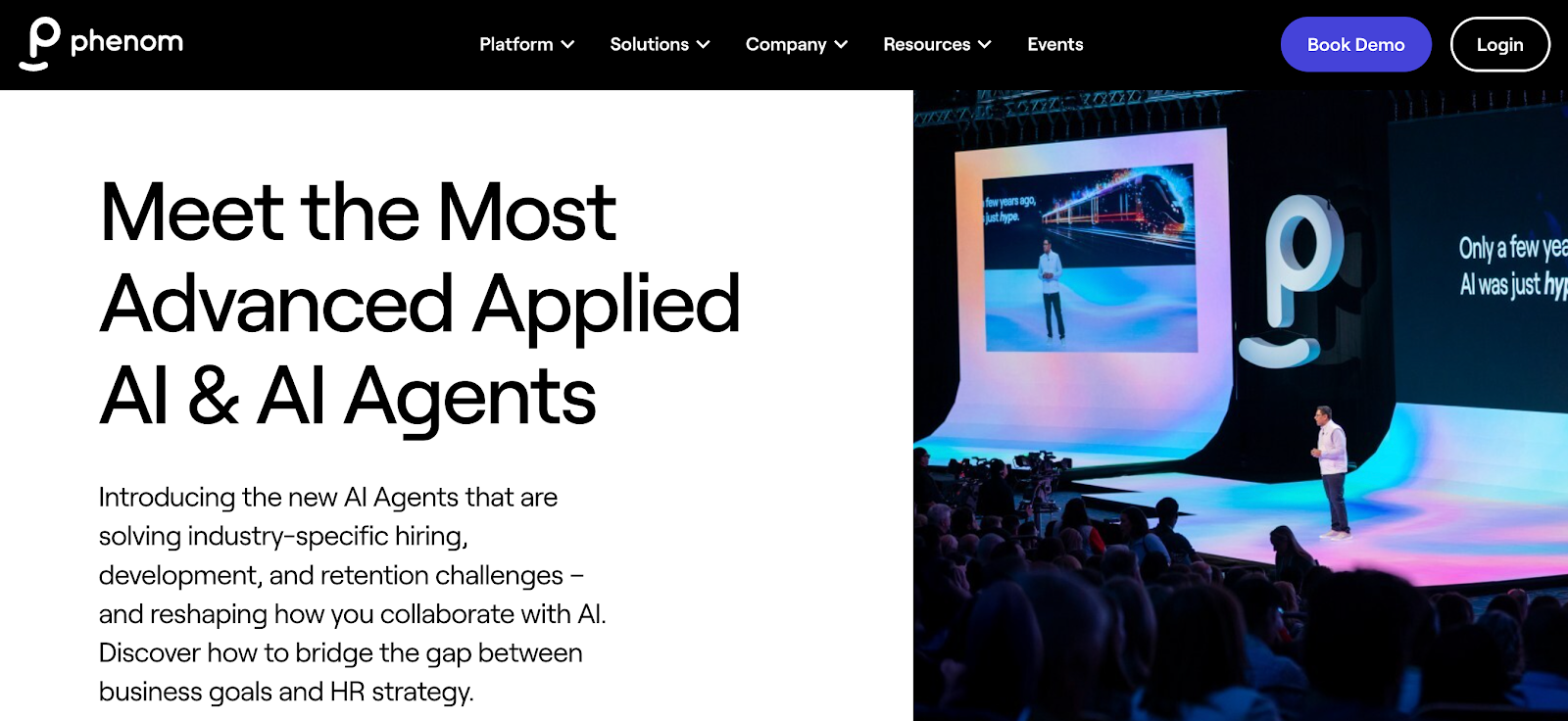
Phenom focuses on making the experience better for everyone involved in the recruitment process, from job seekers to recruiters to hiring managers. It offers AI-powered features that improve how candidates interact with your brand at every touchpoint.
This platform goes beyond sourcing. It helps you manage campaigns, schedule interviews, and build long-term engagement through a unified talent experience.
Key Features
- Personalized career sites with AI-driven job recommendations
- Chatbots that guide applicants through each step
- Event management for university recruiting and in-person hiring
- Texting and branded email templates
- Internal mobility and referral tools
Phenom is helpful for companies that prioritize candidate engagement and want a seamless brand experience. If your team runs frequent hiring events, manages talent communities, or wants more automation in communication, this platform delivers.
Pros
It supports multiple ways to connect with candidates and keeps your messaging consistent. The ability to text candidates and build branded email workflows adds a professional and personal touch.
Cons
The filtering system can be overwhelming at first. Sorting out rejected or withdrawn candidates takes extra time, and support requests often require formal tickets.
Pricing
Phenom does not list pricing publicly.
9. Unnanu Hire — Best for No-Frills Recruiting
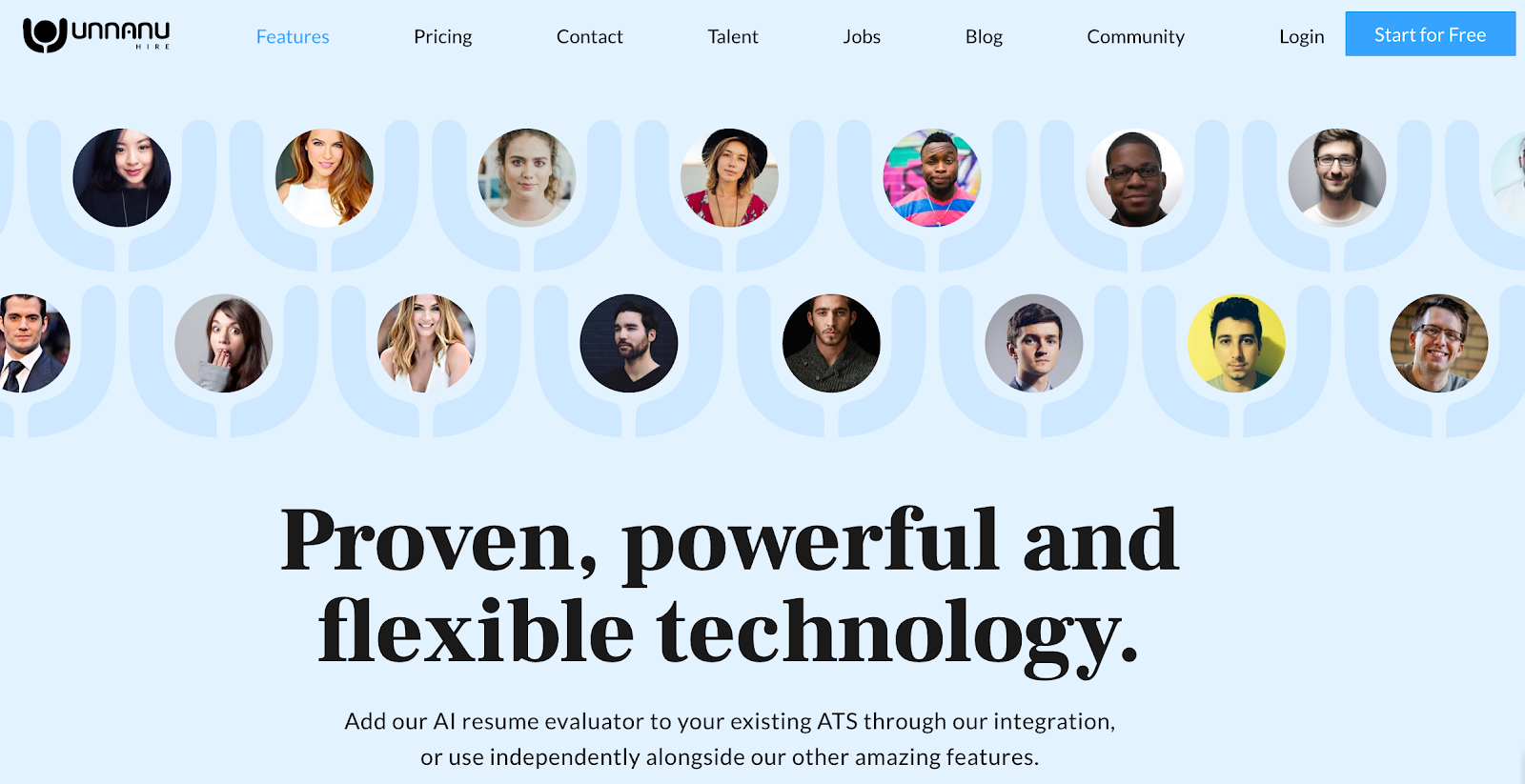
Unnanu Hire is designed for teams that want to move quickly, keep things simple, and still benefit from AI-driven matching.
Its resume scanner and contextual analysis tools help align candidates to roles based on relevance, not just keyword matches.
Key Features
- AI-powered resume analysis and ranking
- Pre-populated talent database
- Video interview tools and automated email follow-ups
- Bulk messaging and offers management
- Bias mitigation features for fair evaluation
Unnanu is suitable for teams that need a simple way to manage high-volume hiring without complex workflows. It can work well for companies posting many roles, but pricing may be a consideration for smaller or early-stage teams.
Pros
The platform includes a free trial with a free job posting and makes it easy to get started. You can quickly reach out to potential candidates using built-in messaging tools and a ready-to-use talent pool.
Cons
Support is limited on lower-tier plans. The AI resume scanner is locked behind a paid plan, and overall pricing may be high for smaller teams or early-stage companies.
Pricing
- Jobboard: $9.99 per month
- Standard: $249 per month
- Pro: $999 per month
10. Findem — Best for Data-Driven Talent Insights

Findem is built for teams that want more than just sourcing. It’s a talent acquisition platform that uses deep data to help you understand every candidate’s skills, experience, and impact before you reach out.
The system pulls from billions of data points to create what it calls 3D candidate profiles. This gives you a clear view of who someone is, how they’ve grown, and whether they fit the role, not just what’s on their resume.
Key Features
- AI-generated 3D candidate profiles
- Talent CRM for outreach, nurturing, and pipeline building
- Campaign tools for outbound messaging
- Integration with ATS platforms
- Historical data that connects people and companies over time
Findem is good for teams that rely heavily on data to drive informed hiring decisions.
Pros
You can upload a job description or LinkedIn profile and instantly get a list of suitable candidates. The search filters are flexible, and the system continuously updates as new data comes in.
Cons
The reporting setup can be confusing, especially when multiple fields have the same name. Running personalized campaigns also takes some extra steps. Pricing is geared toward larger companies and may not be cost-effective for smaller teams.
Pricing
Findem does not publish pricing online.
What Should You Look for in an AI Recruitment Software?
Most hiring teams need the right AI recruitment tool to solve a specific problem. Whether you’re struggling with candidate screening, low response rates, or a lack of qualified applicants, the tool you choose should fix that first.
Use these key factors to guide your decision:
Find Tools That Help You Reach the Right Candidates
A bigger applicant pool means nothing if it’s filled with the wrong people. Focus on platforms that improve talent sourcing and help you surface top talent based on role fit, skills, and signals of intent.
Prioritize Candidate Engagement Features
Getting someone’s attention is only the first step. Look for tools that help you engage candidates effectively and answer candidate questions early. Chatbots, campaign tools, and personalized messaging can all help candidates stay interested through the process.
Look for Features That Save Time and Reduce Bottlenecks
Tasks like interview scheduling and candidate screening take time away from more strategic work. A well-designed AI assistant can handle these tasks and help your team move faster.
Evaluate Tools That Support Better Hiring Outcomes
Beyond automation, some platforms help you generate job descriptions, write job descriptions, and even identify hidden talent through AI algorithms. A few also help reduce hiring bias, giving you a clearer view of who can do the job.
Choose Tools That Fit Into Your Workflow
If a platform slows your team down or adds too many steps, it won’t get used. Prioritize tools that support the entire hiring process in just a few clicks and work with your existing systems.
Turn Your Network Into Your Recruiting Advantage
Most AI recruiting tools help you post jobs, filter resumes, or speed up tasks. That’s useful, but it doesn’t guarantee stronger hires. If your goal is to reach the right people and get them to respond, you need more than automation. You need access to relationships that move the process forward.
Village gives you that access.
Instead of more cold outreach, Village uses AI-powered relationship intelligence to identify warm, trusted intro paths to hiring managers and decision-makers. You get real context, connection strength, and AI tools to help you act on those paths with purpose.
This is what intelligent talent acquisition looks like. You connect with the best candidates. Plus, you attract candidates who are more likely to engage, interview, and accept offers.
Village works with the systems you already use. You can embed it into a platform or use it directly. Either way, it helps you focus on getting people in front of the right decision-makers.
Start using Village for free and turn trusted relationships into your most effective hiring advantage.
FAQs About Best AI Recruiting Tools
What is the best AI recruiting tool?
It depends on what problem you're solving. Workable is solid if you need an all-in-one system. Recruit CRM works well for agencies managing lots of roles. But if you care about getting candidates in front of the right hiring manager instead of just sending cold applications, Village is the only tool built for that. It uses trusted referral paths - something no traditional ATS or sourcing platform can match.
What type of AI is used for recruitment?
Most AI recruiting platforms use machine learning, natural language processing, and predictive algorithms. These technologies help with resume screening, candidate ranking, engagement tracking, and even generating outreach content.
Is ATS an AI tool?
Not always. An ATS (applicant tracking system) is usually a database that helps you manage applications. Some ATS tools now include AI features like candidate matching or outreach automation, but many still rely on manual workflows.
Which is the best AI tool?
There’s no universal winner. It comes down to what your team needs. If you're focused on pipeline automation, platforms like Eightfold or Findem offer deep data. But if you want your platform to help match candidates to real opportunities through referrals, Village is the only AI tool that makes that possible.









